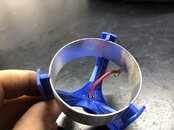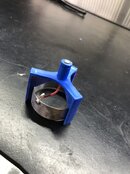In a P21 / Zero the air processing flow is from top to bottom, this is because that so called filter housing is a combo unit with water separator.
P41 and bigger is a stand alone filter housing ONLY, so it is from bottom to top air processing flow, which is better as dirt/wetness can be brought down by gravity...well kinda

If a P21 uses bottom to top air flow, its air will be VERY WET as surrounding the exterior of the P21 blue plastic filter cartridge is wet with water condensate of a water separator, which a P21 is also a water separator. So P21 need air to exit at the bottom and directly to the PMV and then filler hose to make sure air is driest.
View attachment 752134
As I said, if funds allows, always use a stand alone filter housing like P41 or bigger and have a stand alone 2nd*/final water separator ( *3 stage compressor ). A P41 has a check valve between final WS to P41 housing, so no cross wet contamination from WS during compressor inactivity.
The air quality of a P21 is so so but can be VERY GOOD for small numbers of tanks if user uses virgin filter cartridge on that very day air fill is done and user is to NOT KEEP the compressor un-used for too long.
If user is a weekend warriors small group with 3,000PSI 80CF 10 tanks only per weekend and dive per every other week, and the ambient temperature is 30C like most tropical location of when in summer in USA hot zones... by the 2nd week or 2nd airfill session, the P21 which technically still have 20 more tanks fill life is no more as good and dry as 2 weeks ago, as water vapor ( liquid water actually ) in the housing willl hit the media. Afterall P21 interior is so wet... what else can we do ?
Above sad truth is from the inferior filter + WS combo housing a P21 is.
The other issue is too short dwell time of the air flowing among the media 13X, AC and hopefully hopcalite in use too. At approx 65-67 grams of 13X a P21 filter cartridge is vs a P41 at 674 grams which is 10 times more just for the 13X and so many times more for the AC and Hopcalite.... a 200L per minute compressor using P21 filter cartridge size will have air flow 10 times faster compared to using a P41 sized filter cartridge. FAST = BAD & SLOW = GOOD.
These 13X and AC media-s are not like say a fuel or oil filter media which is a particulate filter paper able to trap dirt at XYZ sizes. 13X and AC are sieve, a temporary keeper only and not a trapper and slow flow with deep bed depth is very effective for them. Hopcalite is a catalyst, which slow is also good.
These 2 being a molecular sieve, makes them temporary keeper only and once saturated , they will release** all the baddies ( **breakthrough) into your tank in favor of newly incoming water vapor.
This breakthrough is bad and dangerous.
I used to co-own and/or in charge of maintenance and operation of quite a few compressors since the 90s. Capitano 140, Mariner 200 x 2, Junior 100 and PE100. These are from groups of divers who I dive with. I got a few groups I hang out with and we share $$ to buy these. All uses P21, naturally because it is the lowest cost option. I was still "green' back then and mild smelly air as alarm to change filter cartridge is like
NORMAL .... LOL
Come 2010 and I done the calculation that a P41 is actually better and cheaper in the long run, so personally a P41 was choosen. I had extensive experience with P61 x 2 towers ( aka P81 ) too in 2011 to 2018 there about.
The air quality of P41 or bigger units is just awesome. Once we get used to this kind of air-quality, anything less will be annoying and for those who does not know, the mild headache at the back of the head you guys get, is not only from carbon dioxide build-up aka over-exertion but less than perfect air is the most common cause. Air does not need to be smelly to be bad at depth, that is the danger.
Allrighty...dive safe.





